Managing Requisitions Using the Fluid User Interface
The My Requisitions feature provides you with the ability to review, edit, approve, or cancel requisitions. You can view requisitions in any status. You can only edit active requisitions that have not been sourced and do not have a status of Complete, or Canceled.
After you dispatch a requisition on a purchase order, the goods are received and the supplier is paid. The Requisition Reconciliation process (PO_REQRCON) then identifies the requisition status as Complete. .
This section discusses how to manage requisitions, view requisition details, distribution and chartfields details, value added tax (VAT) details for distributions, edit requisitions, and cancel or reopen requisitions.
|
Page Name |
Definition Name |
Usage |
|---|---|---|
|
PV_MOB_855_ORDR_FL |
View a list of requisitions that you have ordered. |
|
|
PV_MOB_855_ORDRSCF |
View the requisition summary, requisition lifeline, and requisition lines. |
|
|
PV_REQ_INQUIRY_FL |
To get detailed information about the requisition, including comments, attachments, item descriptions, schedules, distributions, and line details. |
|
|
Requisition Line Details - Schedule Details and Line Details Page |
PV_REQ_SCH_DIS_SCF |
View the requisition line and schedule details for the selected line item. |
|
PV_MOB_NEW_CHEKOUT |
To review the contents of the requisition, make final adjustments to quantity and UOM, add last-minute items to the requisition, and to place orders. |
Use the My Requisitions page (PV_MOB_855_ORDR_FL) to view a list of requisitions that you have ordered.
Navigation:
This example illustrates the fields and controls on the My Requisitions page. You can find definitions for the fields and controls later on this page.
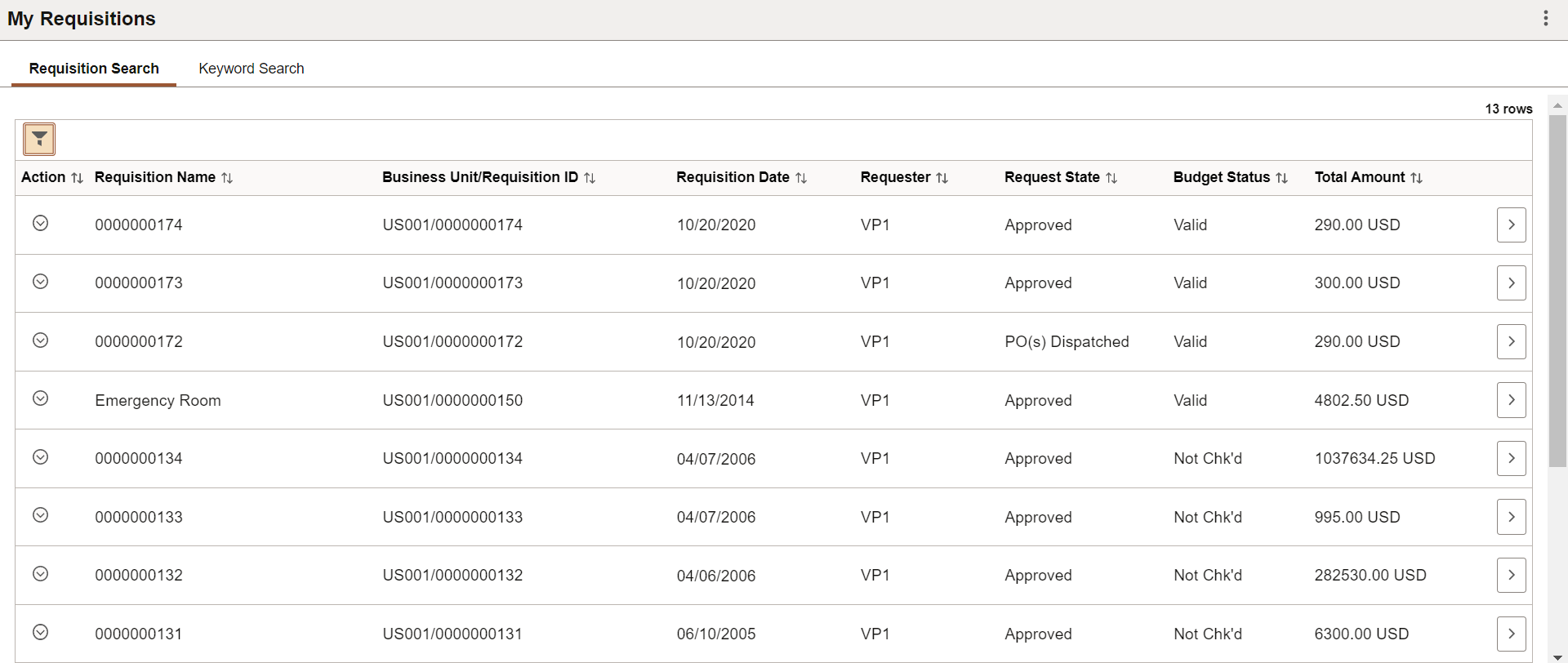
Use this page to review requisitions. From this page, you can access other pages to perform tasks, such as review requisition details, edit or cancel requisitions, create change requests, receive stock, copy requisition, view approvals, or return stock to the supplier.
The number of requisitions shown on this page depends on the configuration done on the eProcurement Installation Options page. The requisitions are displayed based on the From and Through dates, using the default timeframe of 90 days prior to the current date, and irrespective of the business unit or requester ID. The default number of results is 50. However, it is recommended to keep this value low as a large number of items may take longer to display, depending on the hardware configuration and the memory capacity of the system.
Requisition Search Tab
Requisition Search tab displays the list of requisitions based on the filters criteria.
Click the Update Filters button or
 (Filters by icon) to view the Filters page. Enter
search criteria on Filters page and click Done button to display
the requisitions.
(Filters by icon) to view the Filters page. Enter
search criteria on Filters page and click Done button to display
the requisitions.
This example illustrates the fields and controls on the My Requisitions Filters page. You can find definitions for the fields and controls later on this page.
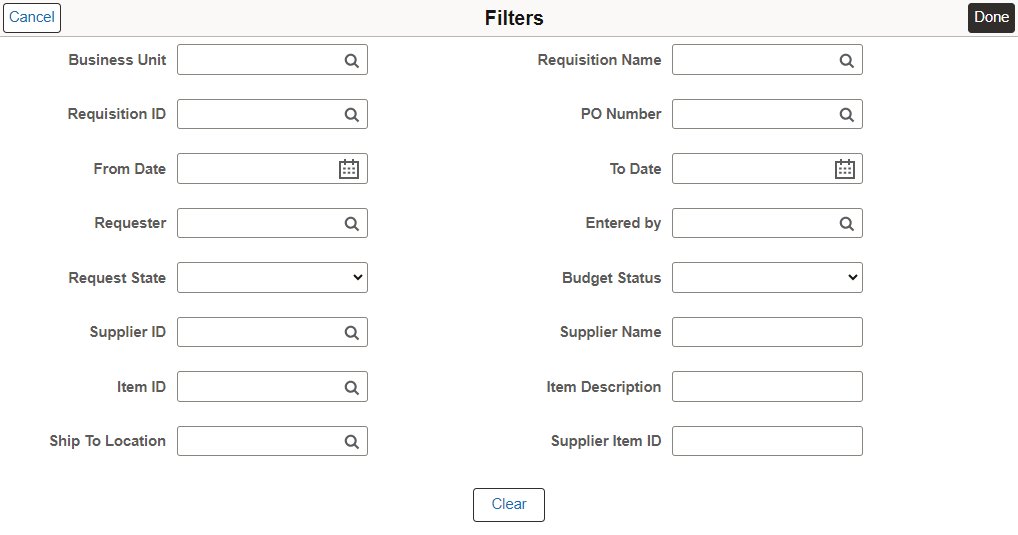
|
Field or Control |
Description |
|---|---|
|
Business Unit |
Select the PeopleSoft business unit. |
|
Requisition ID |
Enter a specific requisition ID to display. |
|
From Date and To Date |
Enter the creation date or range of dates for the requisitions. |
|
Requester |
Enter the requester name of the requisition. |
|
Request State |
Select the state for the overall requisition (header-level) to limit the requisitions displayed to this status. Leave this field blank to display search results without using request state as a search criteria. The following search criteria are included:
|
|
Supplier ID |
Enter or select the supplier ID, or use the Lookup page to select a supplier. |
|
Supplier Name |
Enter the Supplier Name. You can enter the full supplier name or partially. Search results display the requisitions that contain or begin with the entered keyword. This field is not case-sensitive. |
|
Item ID |
Enter the item ID for a requisition line. |
|
Ship To Location |
Enter the ship to location code. |
|
Requisition Name |
Enter the given Requisition Name. |
|
PO Number |
Enter the Purchase Order Number where the requisition was sourced. |
|
Entered by |
Enter the user ID of the individual who entered the requisition. This is usually the requester but can be another individual. |
|
Budget Status |
Displays the header results of a budget check initiated by clicking the Check Budget button or the Pre-Check Budget button. The options are:
|
|
Item Description |
Enter the item description used by the supplier for the item. |
|
Supplier Item ID |
Enter the item ID used by the supplier for the item. |
From Date is defaulted to the last 90 days. If all the fields are left blank on the Filters page except for Business Unit then all the requisitions are retrieved for that Business Unit. Filters page allows to enter partial values and the 'contains' operator is applied to bring results.
Keyword Search Tab
Enter a word (for example monitor) or a string of characters in the Keyword Search box, and then click the Search button to display the requisitions having keyword.
This example illustrates the fields and controls on the My Requisition Keyword Search page. You can find definitions for the fields and controls later on this page.
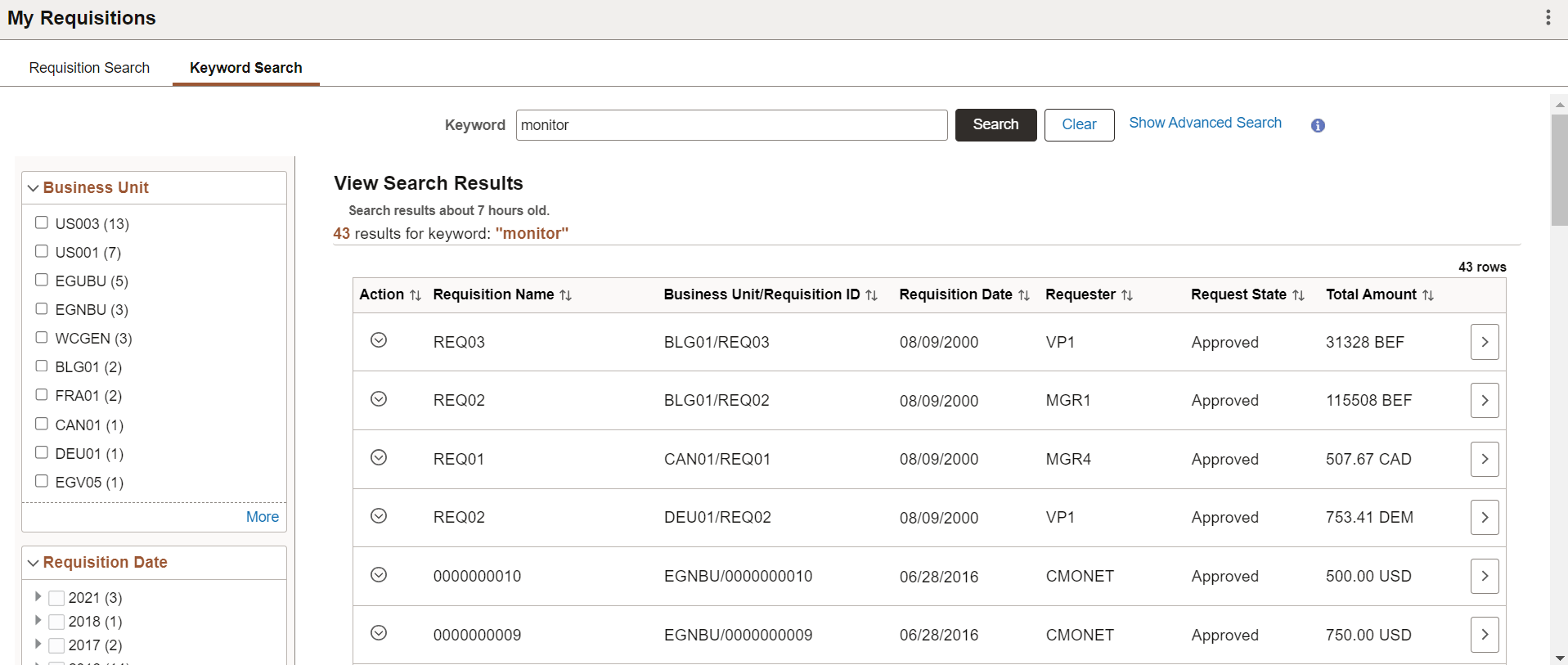
The facets on this page enable you to quickly and easily filter your search results. When you click a facet link, the system displays only the search results associated with the facet. If you select multiple facets, the system filters the search results so that only the search results associated with all of the facets appear.
The available facets are Business Unit, Requisition Date, Requester Name, Budget Checking Header Status, Supplier Name, and Requisition Status.
|
Field or Control |
Description |
|---|---|
|
Clear |
Click to clear the search result and start a new search entry. |
 (Search Tips) |
Click Search Tips icon to view the General Search Guidelines for Keyword Search. |
Advanced Search
Click Show Advanced Search to expand this section to enter much more specific search criteria. In addition to entering values for fields, you can select operands for those field values. For example, if you want to search for requisitions created on 20.10.2020, you can select = and enter same date in the Requisition Date criteria field.
This example illustrates the Advanced Search criteria that you can use to search for positive input entries.

This is an example of search results generated using Advanced Search criteria.
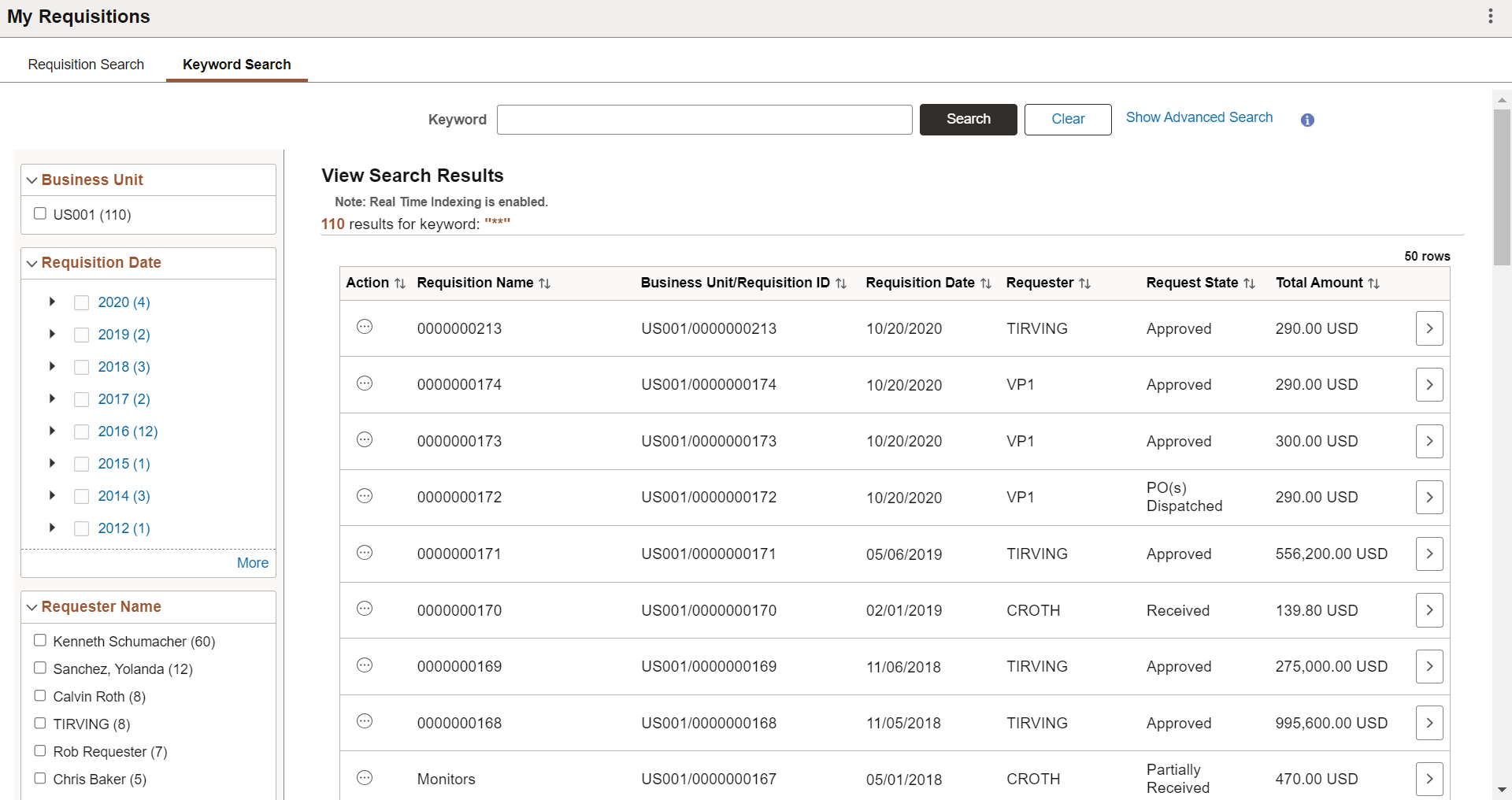
Requisitions
This group box displays requisitions based on the search criteria. Basic information about the entire requisition (requisition header-level) is displayed for each requisition. You can view additional information, including line details by using the details icon.
|
Field or Control |
Description |
|---|---|
|
|
Select the Actions icon to perform the following related action on the requisitions:
Note: The options that appear for a requisition differ depending on the status of the requisition. For example, you cannot cancel a requisition for which a PO is created. |
|
Requisition Name |
Displays the description of the request entered by the requester when the requisition was added. The requisition name helps to identify this requisition as it flows through the system. If no requisition name was entered, then the requisition ID is displayed. |
|
Business Name/Requisition ID |
Displays the PeopleSoft Purchasing Business Unit and requisition ID for this requisition. |
|
Requisition Date |
Displays the date the requisition was created. |
|
Requester |
Displays the ID of the requester who created the requisition. |
|
Request State |
This state field displays the request state across the entire procurement cycle, not just the requisition header state. The following states are included:
|
|
Total Amount |
Displays the total price amount of all the items in the requisition. |
|
|
Select to access the Details Page. |
Use the Details page (PV_MOB_855_ORDRSCF) to view the requisition summary, requisition lifeline, and requisition lines.
Navigation:
. Select the Requisition Details icon.
Or
Click the Related Actions icon and select Details.
This example illustrates the fields and controls on the Details page. You can find definitions for the fields and controls later on this page.
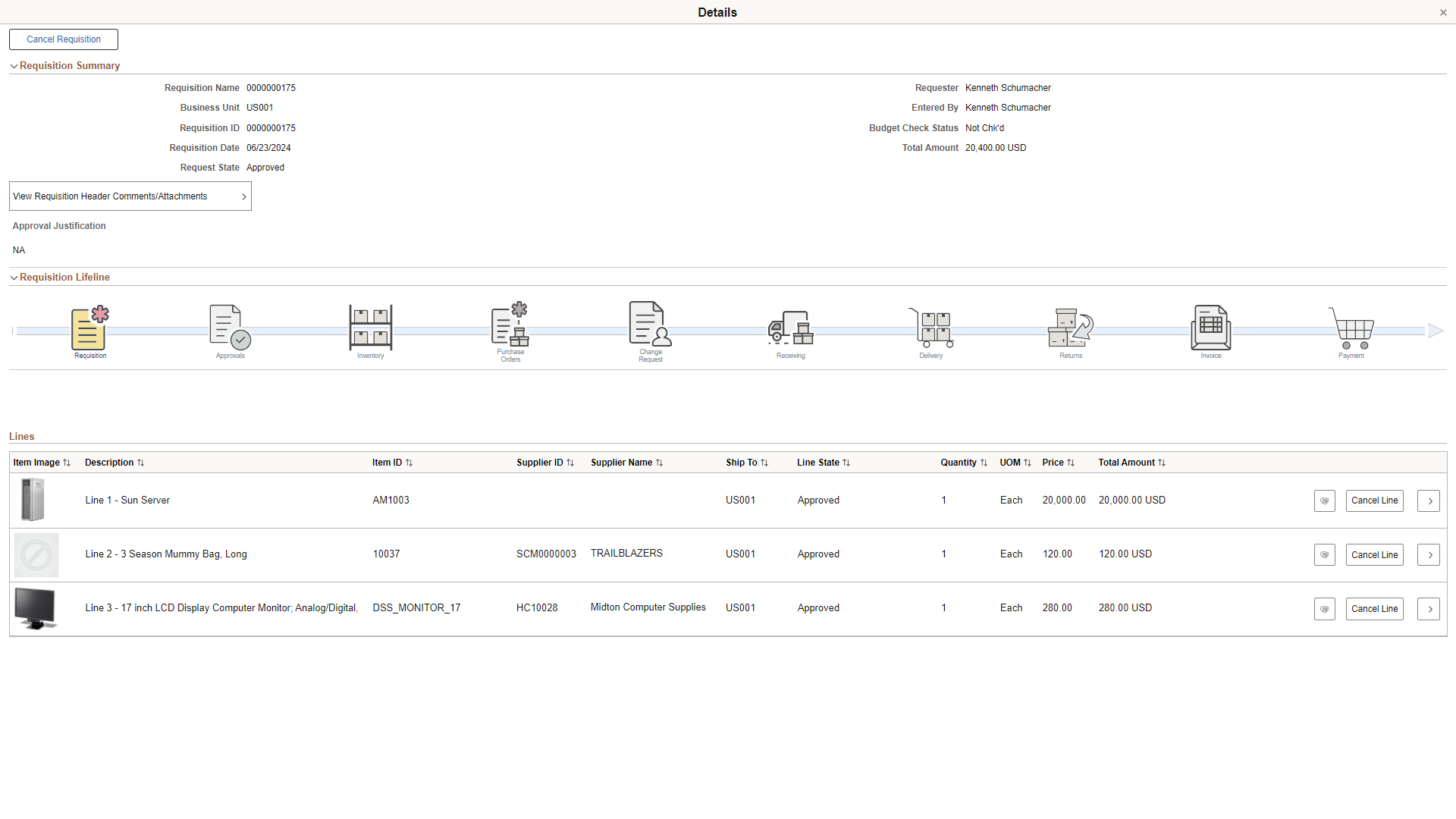
Cancel Requisition: Displays if the Request State is Approved. Select to cancel the entire requisition.
Requisition Summary
Requisition Summary displays the basic details of the requisition: Requisition Name, Business Unit, Requisition ID, Requisition Date, Request State, Requester, Entered By, Budget Check Status, and Total Amount.
Requisition Lifeline
The Requisition Lifeline section displays the business process flow for a requisition with links to various documents. The business process flow or lifecycle, includes icons for requisition creation, requisition approval, sourcing to inventory stock, sourcing to a purchase order, purchase order acknowledgments (POA), advanced shipping notices (ASN), change requests, receiving, returns, invoices, and payment. The icons are highlighted when the requisition has completed the step. Some of the icons link you to additional information on a separate page. In order to view the POA and ASN icons you must select the Requisition Lifeline Options on the eProcurement Business Unit Options page.
Stages in the requisition cycle that are complete or in progress are highlighted with active links.
|
Field or Control |
Description |
|---|---|
|
Requisition |
Click the Requisition icon to access the Requisition Details page (PV_REQ_INQUIRY_FL), where you can view the requisition summary and requisition line details. |
|
Approvals |
Click the Approvals icon to access the Approval Status page (EOAWMA_TXNHDTL_FL), where you can view the current approval status of the requisition and view line approval details. |
|
Inventory |
Click the Inventory icon to access the Stock Requests page (ORDER_INQ_INV), where you can view the material stock request created from this requisition to fulfill the demand using inventory stock. |
|
Purchase Orders |
Click the Purchase Orders icon to access the PO Inquiry page (PV_PO_LINE_INQ2_FL), where you can view the information about the purchase order that this requisition was sourced to; including, the purchase order number, buyer, and supplier. |
|
POA |
Click the POA icon to access the POA Inquiry page (PV_POA_INQUIRY_FL), where you can view the purchase order acknowledgement tied to the selected requisition. Select the Details icon of a purchase order to view its acknowledgement history. |
|
ASN |
Click the ASN icon to access the ASN Inquiry page (PV_ASN_INQ2_FL), where you can view the advanced shipping notice tied to the selected requisition. Select the ASN Details icon of a requisition to navigate to the ASN History page. If there is only one ASN, the ASN History page is displayed directly. |
|
Change Request |
Click the Change Request icon to access the Review Change Requests page (PV_MOB_855_CHNG_FL), where you can view requisition change request details after it has been sourced to a Purchase Order, view change reason, and processing error if any. |
|
Receiving |
Click the Receiving icon to access the Manage Receipts page (PV_RECV_UPDATE_REQ), where you can view the purchase order receipt linked to your requisition. |
|
Delivery |
Click the Delivery icon to access the Delivery Details page (PV_DELV_DTL_INQ_FL), where you can view the detailed delivery information for a receipt. If there are multiple receipts for a requisition, then the Delivery Summary page is displayed when you click the Delivery icon. You can view details of each receipt from this page. |
|
Returns |
Click the Returns icon to access the Manage Return To Vendor (Supplier)s page (PV_RTV_UPDATE_REQ), where you can view the RTV linked to your requisition. |
|
Invoice |
Click the Invoice icon to access the Invoice Inquiry (PV_PO_INQ2_FL), where you can view the requisition, purchase order, receipts, vouchers, and Invoice Number. |
|
Payment |
Click the Payment icon to access the Payment Inquiry page (PV_PYMNT_INQ2_FL), where you can view the payment details for the selected purchase order. |
Lines
The Line Information group box displays information about each line within the requisition.
Line details provides the item name, description, item ID, supplier ID, supplier name, ship to, line state, item quantity UOM, item price, and total price for each item row.
|
Field or Control |
Description |
|---|---|
|
Line State (at the requisition line level) |
This status field displays the status of the requisition line. The statuses include:
|
 |
Click this icon to cancel a line on the requisition. You can cancel a requisition that has been sourced to a purchase order. If the cancellation completes budget checking and workflow approval, then the system creates a change request for cancelling the corresponding purchase order lines. A requisition line cannot be cancelled if you are using Commitment Control and the line has not yet pass budget checking. Also when a requisition line is sourced to multiple purchase orders it cannot be cancelled. If the approval process includes one or more stages that have only header level approval and a requisition line is cancelled, the entire requisition is resubmitted for approval for the entire approval process. For example, all stages are resubmitted. If the approval process includes one or more stages that have only line-level approval and a requisition line is cancelled, the line approval thread is terminated. If the approval process includes two or more stages that have a combination of line-level and header-level approval and a requisition line is cancelled, the line-level approval thread is terminated if the current stage that the approval is on is a line-level approval. If the current stage is a header-level , then the requisition is resubmitted for the entire process. |
|
|
Select to access the requisition schedule details. For more information, see Requisition Line Details - Schedule Details and Line Details Page. |
Use the Requisition Details (PV_REQ_INQUIRY_FL) page to get detailed information about the requisition, including comments, attachments, item descriptions, schedules, distributions, and line details.
Navigation:
.
.
This example illustrates the fields and controls on the Requisition Details page. You can find definitions for the fields and controls later on this page.

Note: This page displays the information in read-only mode.
Requisition Summary
|
Field or Control |
Description |
|---|---|
|
Requisition Name |
Displays a description of the request to help you identify this requisition as it flows through the system. If this field is left blank, the system uses the requisition ID as the name. |
|
Priority |
Displays High, Medium, or Low to indicate the priority to the approver. |
|
Header Comments |
Select to access the Requisition Header Comments and Attachments window. This page is also used to indicate whether the comment is sent to the supplier, show the comment at receipt, and show the comment at voucher. |
Justification Comments
Displays comments to justify the need for the requisition.
Requisition Lines Overview
This section displays actions applied to the selected one or many lines.
|
Field or Control |
Description |
|---|---|
|
Item Description |
Click the Item name to view the item description page. |
|
Line Comments |
Select to access the Requisition Line Comments and Attachments page. |
|
Quantity |
Displays the quantity of the line item. Note: If the Amount Only toggle is set to Yes for any requisition line, the Quantity value is set to 1 and becomes display only for that line. |
|
Unit of Measure |
The unit of measure in which the item is purchased. |
|
Price |
Displays the item price per unit. |
|
Currency |
Displays the currency of the price. |
|
Total |
Displays total price for the items on that line. |
 View Details icon |
Select to access the Requisition Line Details - Schedule Details and Line Details Page. |
Use the Requisition Line Details (PV_REQ_SCH_DIS_SCF) page to view the requisition line and schedule details for the selected line item.
Navigation:
.
Click View Details icon for any of the item.
This example illustrates the fields and controls on the Requisition Line Details - Schedule Details page. You can find definitions for the fields and controls later on this page.
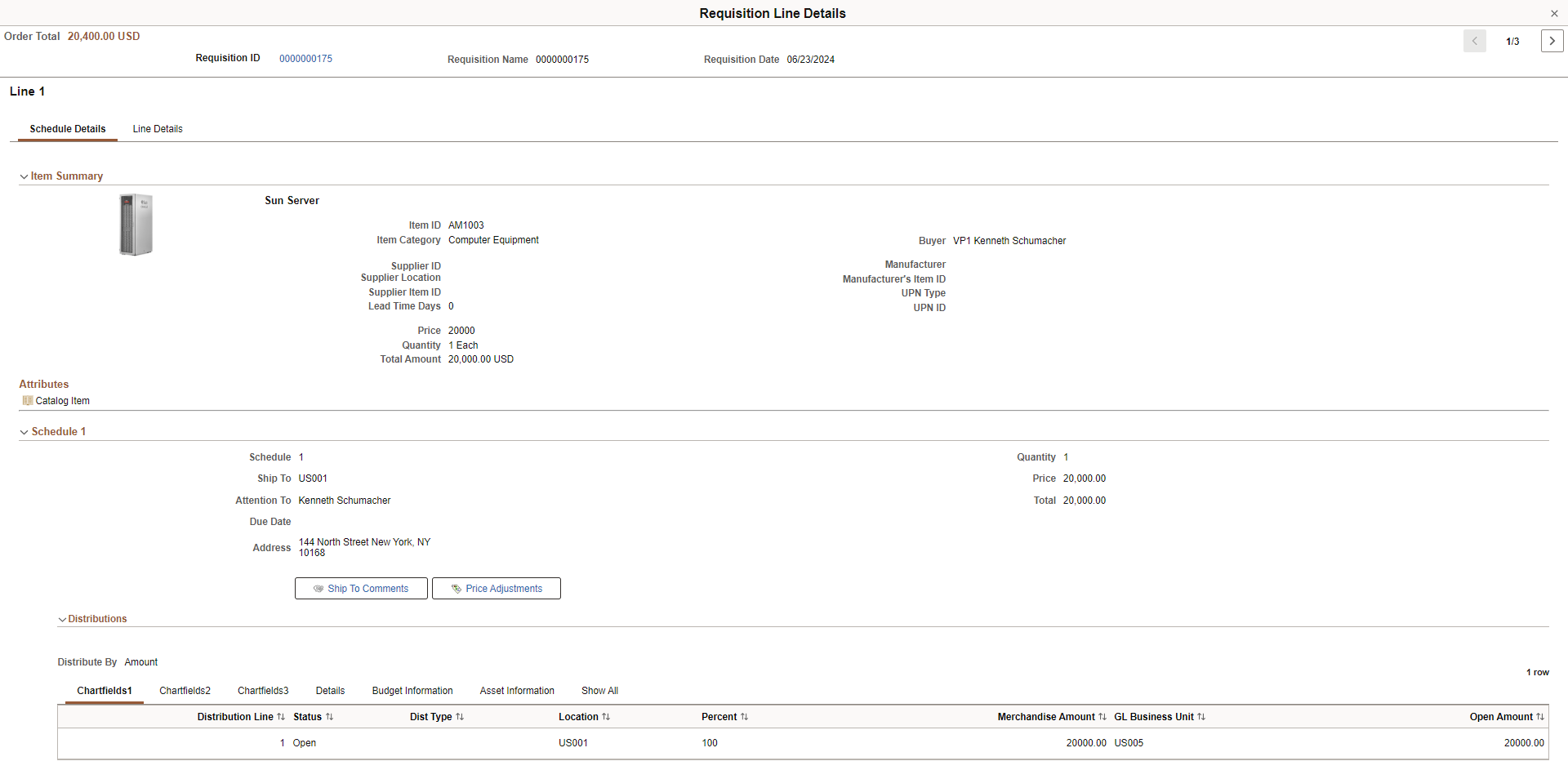
Requisition Line Details page displays the Order total amount, Requisition ID, Requisition name, and Requisition Date.
Note: This page is view only when accessed from the My Requisition page.
Item Summary
Item Summary displays item information, such as Item Image, Item ID, Item Category, Supplier ID, Supplier Location, Supplier Item ID, Lead Time Days, Price, Quantity, Total Amount, Buyer, Manufacturer, Manufacturer's Item ID, UPN Type, and UPN ID.
If you have substitute items defined for the original item, displays the original Item ID on the transaction line that was replaced when a Substitute Item was found. Once the field is populated, the original Item ID will not be overridden with another Item ID. If the Item ID field is changed directly by the Requester or Buyer, the Original Substituted Item field is cleared. Similarly, if the Supplier ID/ Location field is changed by the Requester or Buyer, then the value in the Original Substituted Item field is cleared and the value is moved back to the Item ID field. The substitute items icon helps the Requester or Buyer to know whether the item has been substituted. This appears on a transaction line whenever the Original Substituted Item field is populated. If Original Substituted Item and Description fields are already displayed in the component, i.e. Requisition and PO, a text ‘Substitute Item in Use’ will appear.
Requisition Line Details - Schedule Details
Use the Next or Previous icon on the top right to review each line item.
|
Field or Control |
Description |
|---|---|
|
Ship To |
The location code that indicates the location where the supplier should deliver the items. |
|
Attention To |
Displays the name of the individual who should receive the items or services on this requisition line. |
|
Due Date |
The date the requester would like the items to arrive at the Ship To location. |
|
Address |
Displays the shipping address of the item. |
|
Quantity |
Displays the total requested quantity. |
|
Price |
Displays price of each item. |
|
Total |
Total price of the number of items requested for that line. |
|
Schedule VAT |
Click the Schedule VAT icon to access the VAT Information for Schedule page, where you can review value added tax (VAT) information for the schedule line. The icon does not appear when the Calculate VAT on Req check box at Purchasing business unit level is not selected, the purchasing business unit is not in a VAT environment , or the VAT_DETAILS eProcurement role action is not used and the user eProcurement role is not added to the user ID profile. Using this page, you can override the recovery percentage and rebate percentage, and recalculate or reset VAT defaults changes that are made to VAT determinants. See Understanding VAT. |
 |
Click Ship to Comments button to view comments and attachments. |
 |
Click Price Adjustments button to view the price adjustments for the schedule. |
PO Information
This link appears if the requisition item is sourced to PO. Click this link to view the PO information that opens in a secondary page.
|
Field or Control |
Description |
|---|---|
|
Receipt Status |
Displays the receipt status for this PO. Values include: PO Not Received: No quantities for this PO line have been received. PO Partially Received: Part or all quantities for this PO line have been received. Even if the quantity is fully received, the status does not change until you run the Match Request process in PeopleSoft Payables. PO Received: All quantities for this PO line have been received. Run the Matching process (AP MATCHING) in PeopleSoft Payables. |
|
View Receipt |
Click the View Receipt button to access the Receipt For a Casual User page. This button appears if a receipt was recorded for this line. |
Requisition Line Details - Distribution Details
Distribution displays Accounting Tag information, ChartFields, and access Budget and Asset information.
|
Field or Control |
Description |
|---|---|
|
ChartField |
ChartField Display Templates are used to extend ChartField configuration to control the display of individual ChartFields on PeopleSoft Fluid components. It displays ChartFields in a consistent manner on PeopleSoft Fluid transaction pages across PeopleSoft products. |
|
Distribution VAT |
Click the Distribution VAT icon to access the VAT Information for Distribution page, where you can review value added tax (VAT) information for the distribution line. This button only appears when the Calculate VAT on Req check box for Purchasing business unit is selected, the purchasing business unit is using a VAT environment, or the VAT_DETAILS eProcurement role action is used. |
 |
Click to view the exchange currency information and the exchange rate. |
 |
Click to view the Custom Fields for Line 1 and Schedule 1 and Distribution 1 page that opens in a pop-up window. The custom field values appearing on this page are display only. |
Chartfields
Chartfields displays the distribution line details.
|
Field or Control |
Description |
|---|---|
|
Distribution Line |
Displays the number the system assigned to this distribution. The system uses this numbering to distinguish between multiple distributions for a single requisition line. |
|
Status |
Distribution statuses include: Open: The distribution line is open. Complete: The distribution line is closed. Processed: The distribution line has been processed and is unavailable for sourcing. Canceled: The distribution has been canceled. |
|
Dist Type |
Displays the distribution type that was selected for the requisition line. Values are Labor and Expense. |
|
Merchandise Amount |
Displays the supplier's unit price and currency for the item, which are assigned on the Supplier's UOM & Pricing Info (supplier's UOM and pricing information) page. |
Know more about delivered Chartfields in eProcurement, see Delivered ChartFields.
Details
Details tab displays Affiliate, Fund Affiliate, Operating Unit Affiliate, IN Unit, Stat, Open Quantity, Merchandise Amount Base, and Currency details.
To know more about these fields, see Delivered ChartFields.
Budget Information
|
Field or Control |
Description |
|---|---|
|
Budget Status |
When Commitment Control for purchasing is enabled, displays the distribution line results after budget checking is initiated. Values for the field include:
|
|
Pre-Encumbrance Balance |
Displays the pre-encumbrance balance for this requisition distribution after it is successfully budget checked. Click the Pre-Encumbrance Balance amount hyperlink to view requisition accounting entries for this distribution only. You can use this page to view accounting information details including the commitment control ledger group and transactions that have been performed against this requisition distribution. When this requisition line and distribution is sourced to a purchase order and budget checked, commitment control liquidates the pre-encumbrance balance from this requisition distribution and establishes an encumbrance for the purchase order. |
|
Currency |
Displays the currency code for the pre-encumbrance amount at the distribution level of the requisition. The currency code is based on the commitment control ledger group for the distribution level General Ledger business unit. |
|
Pre-Encumbered Base Balance |
Displays the pre-encumbrance balance in requisition base currency. |
|
Business Unit Base Currency |
Displays the base currency of the pre-encumbrance balance on the business unit. |
|
Commitment Control Close Flag |
Displays as selected when the Purchase Order associated with the requisition is finalized for less, thus indicating that the outstanding pre-encumbrance has been fully liquidated. This flag also displays as selected when the requisition distribution has been canceled. When the requisition is closed and remaining pre-encumbrance amount liquidated on the budget, this flag displays as selected on the requisition distribution. |
Asset Information
|
Field or Control |
Description |
|---|---|
|
AM Business Unit |
Displays the Asset Management Business Unit. |
|
Profile ID |
Displays the default asset profile ID associated with distribution items. |
|
Tag Number |
If you use tags to track assets, enter the tag number assigned to the asset. |
|
CAP # |
The CAP identification ties the asset to a capital acquisition plan. |
|
Sequence |
Displays the sequence number for the capital acquisition plan. |
|
Empl ID |
Employee ID of the custodian for this distribution item. |
|
Capitalize |
Select to designate this item as a capitalized item. If the item is capitalized, it can be depreciated before the order is paid. |
|
Cost Type |
Displays the default cost type associated with the item purchase, if applicable. Cost types represent components of the cost of an asset, such as materials, labor, and overhead. |
VAT Details For Distribution Page
Use the VAT Details for Distribution page (PV_MOB_DIS_VAT_SCF) to review value added tax (VAT) information for the distribution line.
The page does not appear when the Calculate VAT on Req check box at the Purchasing business unit level is not selected, the purchasing business unit is not in a VAT environment, or the VAT_DETAILS eProcurement role action is not used. Using this page, you can override the recovery percentage and rebate percentage, and can recalculate or reset VAT default changes that are made to VAT determinants.
Navigation:
Click the Distribution VAT icon on the Requisition Details page.
Use this page to view VAT details at the distribution line level. Information that appears on the page relates to the requisition line number item and the schedule that you selected on the Manage Requisitions page. The page does not appear when the Calculate VAT on Req check box at the Purchasing business unit level is not selected, the purchasing business unit is not in a VAT environment, or the VAT_DETAILS eProcurement role action is not used. Using this page, you can override the recovery percentage and rebate percentage, and can recalculate or reset VAT defaults changes that are made to VAT determinants.
VAT Defaults
|
Field or Control |
Description |
|---|---|
|
Use Type |
Determines VAT recoverability. The field value is retrieved from the VAT default hierarchy, but you can override this value. Use type is a type of activity in which a purchased good or service will be used and, therefore, to determine a recoverability percent and a rebate percent (when applicable) that is applied to a transaction line. Activities are categorized as taxable, exempt, or mixed. Where activity is mixed, you can associate either the ratio of taxable activity to exempt activity directly with the use type, or you can indicate that this ratio is determined at the ChartField level. |
|
Apportionment Control |
Displays the business unit that you want to control the VAT apportionment. This value appears by default from the Purchasing business unit. VAT apportionment is the mechanism that enables you to specify the ratio of taxable activity to exempt activity for individual ChartFields. |
|
Recovery Source |
Select whether the VAT recovery is Automatic or Manual. This value appears by default from the Purchasing business unit. If you select Manual, enter a value in the Recovery Percent field. |
|
Rebate Source |
Select whether the VAT rebate is Automatic or Manual. This value appears by default from the Purchasing business unit. If you select Manual, enter a value in the Rebate Percent field. |
|
Treatment |
Controls default and transaction behavior. A description of how the transaction must be treated for VAT purposes. This value is used to determine how VAT defaults are applied, what accounting entries are required, and how and if the transaction is reported on the VAT return. You can override the values in this field. The VAT defaulting hierarchy determines the value of this field based on the country in which the service is deemed to have been performed, and the countries in which the bank and beneficiary are located and registered. |
|
VAT Code |
Select a value to specify the rate at which VAT is calculated. The VAT code used to define a percentage the system uses to determine the VAT amount. The VAT code is similar to the sales and use tax code, with a few exceptions. The tax authority tied to the VAT code generally consists of a single authority, and the ChartFields for a VAT code do not reside with the tax authority but are determined by the combination of the VAT code, VAT account type, and VAT transaction type. |
|
Transaction Type |
Select a value to categorize VAT transactions according to particular VAT accounting and reporting requirements. The VAT code and the VAT transaction type are used in conjunction with the VAT account type to obtain the ChartFields for accounting entries. |
VAT Calculations
|
Field or Control |
Description |
|---|---|
|
Transaction Amount |
VAT amount in the transaction currency. |
|
Transaction Amount Base |
VAT amount in the base currency. |
|
Basis Amount |
VAT basis amount in transaction currency. |
|
Basis Amount Base |
VAT basis amount in the base currency. |
|
Tax Rate |
Displays the rate at which this item is taxed. |
|
Recorded Amount |
Displays the amount of VAT calculated for the schedule in the transaction currency. |
|
Recorded Amount Base |
Displays the amount of VAT calculated for the schedule in the base currency. |
|
Recovery Percent |
Displays a system-calculated value based on the selected VAT use type. You can override the automatic value if the VAT Allow Override Recovery/Rebate field on the business unit indicates that manual override is allowed. This value must be less than or equal to 100 and a positive number. To access the field, select and click the Set VAT Default link. |
|
Rebate Percent |
Displays a system-calculated value based on the selected VAT use type. You can override the automatic value if the VAT Allow Override Recovery/Rebate field on the business unit indicates that manual override is allowed. This value must be less than or equal to 100 and a positive number. To access the field, select and click the Set VAT Default link. |
|
Recovery Amount |
VAT recovery amount in the transaction currency. |
|
Recovery Amount Base |
VAT recovery amount in the base currency. |
|
Rebate Amount |
Calculated VAT rebate amount in the transaction currency. |
|
Rebate Amount Base |
Calculated VAT rebate amount in the base currency. |
Requisition Line Details - Line Details
This section displays additional details for a line, such as the buyer, supplier, and other line-specific information.
Navigation:
Select Line Details on the Requisition Line Details page
This example illustrates the fields and controls on the Requisition Line Details - Line Details page. You can find definitions for the fields and controls later on this page.
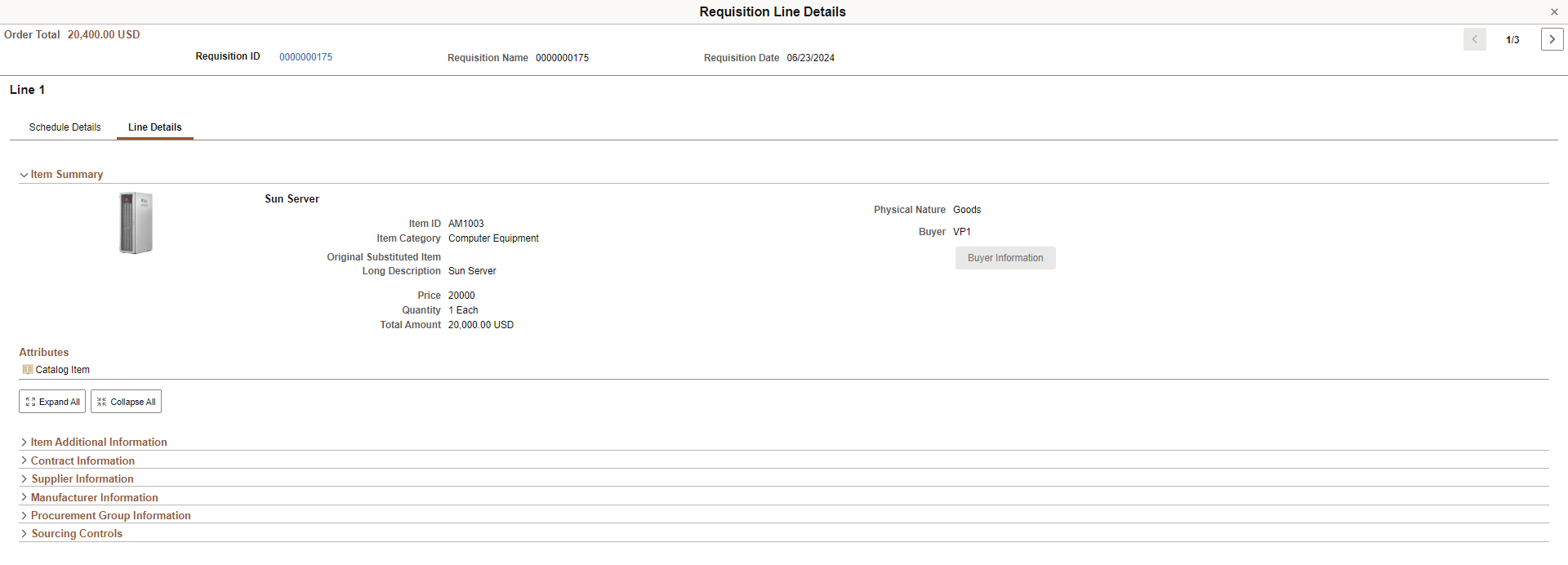
|
Field or Control |
Description |
|---|---|
|
Buyer |
Displays buyer name. |
|
Buyer Information |
Select to access the Buyer Telephone Information window, which displays the buyers name, telephone, and fax number. |
|
Show Configurator |
Select to access the Item Configuration Information window, where you can select an Inventory Unit and Configuration Code. |
Item Additional Information
|
Field or Control |
Description |
|---|---|
|
Device Tracking |
Displays whether a receipt line is device tracked. See Using Device Tracking |
|
Stockless Item, , |
Aagreement has been set up with the supplier to supply this item for par inventory replenishment. |
|
RFQ Required |
Item must go through the RFQ cycle before it can be included on a purchase order. |
|
Inspection Required |
Inspection required for the item. |
|
Amount Only |
Displays Yes to indicate that the line is an amount only line. |
|
Auto Item Substitution |
Indicate that item substitutions can be determined by the system. This is determined by Purchasing business unti. |
Contract Information
This link appears if a contract ID has been assigned to the requisition line. Click this link to view contract details that opens in a secondary page.
The PeopleSoft eProcurement, PeopleSoft Purchasing, and PeopleSoft Payables applications are integrated with the procurement contract functionality to streamline the use of contacts with requisitions, purchase orders, and vouchers. As part of the contract functionality, you can set up requisitions to automatically search for a contract to use for requisitions. Applying default contract prices to requisitions enables you to receive contract prices for requisition items and to more accurately track budgets and pre-encumbrance balances.
|
Field or Control |
Description |
|---|---|
|
Contract ID |
Displays the purchasing contract used to price this requisition line. The contract ID can be entered manually on the Review and Submit-Line Details page when creating and editing a requisition. A contract ID can also be added automatically by the system when you have selected the Default Contract On Req check box on the Purchasing Definition - Business Unit Options page. |
|
Version |
Displays the contract version applied to this requisition line. Multiple versions are available when you are using version control. Contract versions enable contract administrators to create and maintain multiple versions of a contract in the procurement system. |
|
Contract Line |
Displays the contract line applied to this requisition line. |
|
Category Line |
Displays the contract category line number. Categories enable you to specify groups of items on a contract, rather than having to enter the items one at a time. |
Supplier Information
|
Field or Control |
Description |
|---|---|
|
Supplier ID |
Displays the ID of the supplier that supply this item. |
|
Supplier Location |
Displays the location of the supplier. The default is based on the value that is defined for the supplier. |
|
Supplier Item ID |
Displays the ID that the supplier uses to identify this item on the Item Supplier page. |
|
Supplier's Catalog Number |
Displays the Catalog Number that the supplier assigned for the item. |
|
Item Supplier Priority |
Indicates the supplier priority selected for the item. The value appears by default as a medium priority, but can be changed by the user. The updated priority appears on the Requisition Header. |
|
Suggest New Supplier |
Select this link to access the Suggested Supplier page (PV_MB_SUG_VNDR_SEC) where you can enter supplier name, address, and phone information. |
Manufacturer Information
The Manufacturer information group box displays all information pertaining to the manufacturer.
|
Field or Control |
Description |
|---|---|
|
Manufacturer ID |
Identifies the manufacturer of the item. This value is supplied from the Supplier’s Manufacturer Info page. |
|
Manufacturer's Item ID |
Displays the identifier that the manufacturer uses for this item when the suggested supplier supplies the item. This value appears from the Supplier's Manufacturer Info page. |
|
UPN Type |
Displays UPN Type Code. |
|
UPN ID |
Displays universal product number that is defined by a unique combination of item ID, manufacturer ID, manufacturer item ID, and Unit of Measure. |
Procurement Group Information
|
Field or Control |
Description |
|---|---|
|
Procurement Group ID |
Displays Procurement Group ID. |
|
Primary Unit |
Indicates that this is the primary unit for the Procurement Group. |
|
Unit Allocation Qty |
Identifies the quantity allocated per asset for the Procurement Group. |
Sourcing Controls
|
Field or Control |
Description |
|---|---|
|
Consolidate with other Reqs |
Displays if multiple requisitions are consolidated for the same supplier into one purchase order. This is defined at requester setup. |
|
Calculate Price |
Displays Yes if the sourcing process recalculated the item price when this requisition line enters the sourcing stage. |
|
Override Suggested Supplier |
Displays Yes the sourcing process to overridden the suggested supplier. This is determined for purchasing order sourcing. |
|
Inventory Source Flag |
Displays whether eligible requisition items are sourced from PeopleSoft Inventory, which is determined in user preferences. |
|
Auto Item Substitution |
Indicates that item substitutions can be determined by the system. This is determined by Purchasing business unit. |
Use the Edit Requisition page (PV_MOB_NEW_CHEKOUT) to review the contents of the requisition, make final adjustments to quantity, UOM, add last-minute items to the requisition, and to place orders.
Navigation:
. Select the Action icon and then select Edit.
This example illustrates the fields and controls on the Edit Requisition page (1 of 2). You can find definitions for the fields and controls later on this page.
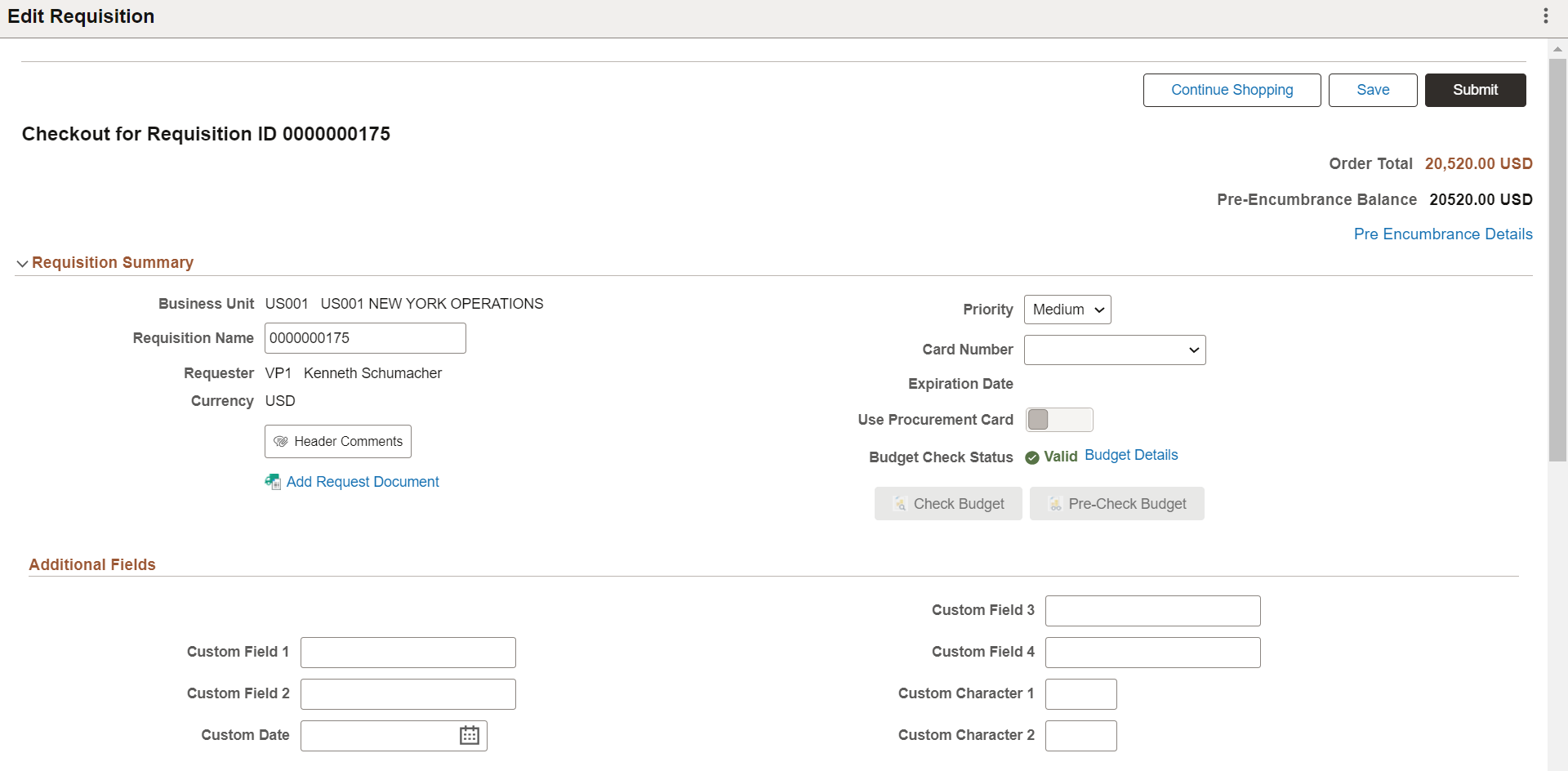
This example illustrates the fields and controls on the Edit Requisition page (2 of 2). You can find definitions for the fields and controls later on this page.
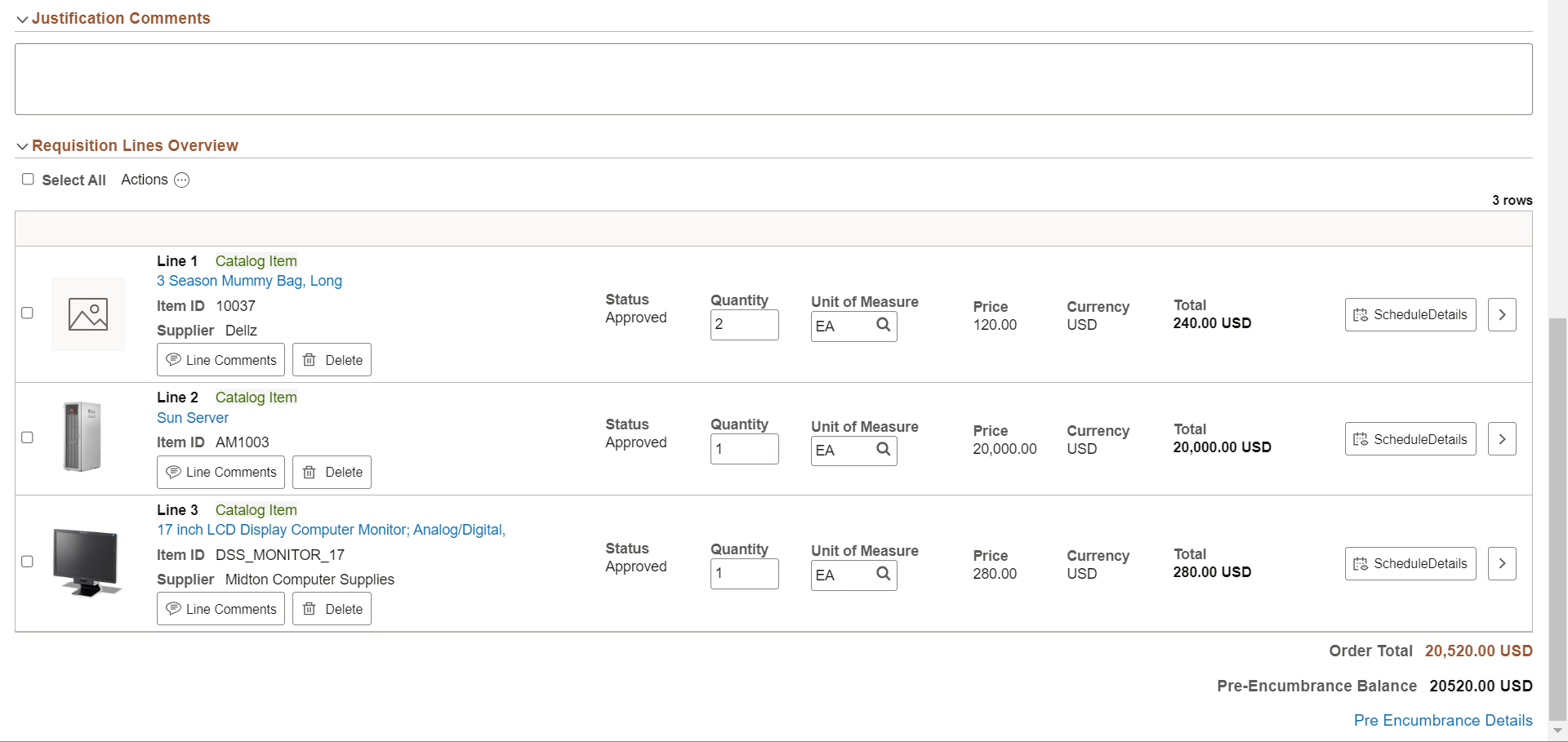
Field or Control |
Description |
|---|---|
Item Description |
Click the item description link to view the item details. For Catalog items, the details are read-only, whereas you can modify the details of Punchout items, Special Request items, Fixed Cost items, and Time and Materials items. Note: If a requisition has been sourced, you will not be able to change the Quantity and UOM field values on the Checkout page. The values can be modified on the Schedule Detail page. |
Quantity |
Modify the quantity if required. |
UOM |
Modify the UOM if required. |
|
VAT Amount (value added tax amount) |
Displays the amount of value added tax (VAT) calculated on a VAT-enabled requisition. It does not appear when the Calculate VAT on Requisition check box at Purchasing business unit level is not selected, the purchasing business unit is not in a VAT environment, the VAT_DETAILS eProcurement role action is not used, and the user eProcurement role is not added to the user ID profile. In addition, for Purchasing Requisition in a VAT enabled Business Unit, VAT Amount and icon also do not appear when the User ID Preferences - Requisition Authorizations for Allowed Requisition Actions of View/Override VAT Details is not selected. |
|
Pre-Encumbrance Balance |
Displays the pre-encumbrance balance amount after requisition is successfully budget checked. When you use commitment control, the system deducts each type of financial obligation from the budget and tracks it according to obligation type. This enables you to determine the money that you have committed in pre-encumbrances. The system extracts these values from commitment control tables by passing the business unit, document ID, and other key information that depends on the display. The system displays this field only when commitment control for purchasing is enabled and if the document has been budget checked successfully at least once. In addition, a default commitment detail ledger must be selected on the Ledgers For A Unit – Commitment Control Options page so that the accounting entries can be summarized to display the respective pre-encumbrance balance for the requisition. Pre-encumbrance balance appears in the transaction currency of the requisition and is based on the transaction budget date, general ledger unit, and commitment control ledger group. Pre-encumbrance balance can be partially or fully liquidated from purchase orders. Click the Pre-Encumbrance Balance amount hyperlink to view Requisition Accounting Entries. You can use this page to view accounting information details including the commitment control ledger group and transactions that have been performed against the requisition. |
|
Delete |
Click to delete selected requisition lines. You cannot delete a requisition line that has been sourced to a purchase order. You cannot use this button to delete a requisition line that has not passed budget checking when Commitment Control is used. |
|
Save |
Click to save the requisition for later review or submission. |
|
Submit |
Click to submit the requisition for approval, sourcing, and dispatching to a supplier. |
The Quantity and UOM values are retained the next time the Checkout page is accessed. You have the options to continue shopping, save your modifications, and submit the requisition.
Note: If you have changed a requisition, upon submission, the Change Request/Line Approval Summary page is displayed with the details such as, line number, item description, change request status. The Line Re-Approval details are displayed only if the required Approval Framework Control options are selected on the Purchasing Definition - Req Change Options page.

 (Details)
(Details)